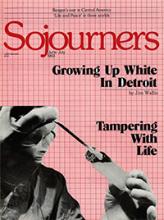From April 20 to 24 I participated in the Christian World Conference on Life and Peace in Uppsala, Sweden, where I was one of 133 delegates from 60 countries. It was the broadest gathering of church leaders I had ever attended. We came from Protestant, Roman Catholic, and Orthodox churches, from both East and West, from the so-called First, Second, and Third Worlds.
Most of those who gathered in Uppsala were heads of churches and communions, bishops, archbishops, and cardinals, with a few of us representing movements in the church's life. The conference was called and convened by the leaders of the Scandanavian churches in response to the urgent nuclear threat.
An initial draft of the conference statement was very moderate, predictable, and, in my view, inadequate. In response to the first draft, a strong bond began to emerge between the younger generation of American and European delegates and the Third World church leaders. Both groups were unhappy with the first statement, and together we pressed for a much stronger commitment to the vital link between peace and justice and a clear rejection of nuclear weapons.
To the astonishment of many of us, the stronger language proposed was incorporated into the second draft of the conference message. The new draft clearly links the struggle for peace and the labor for justice as parts of the same movement. The statement fundamentally challenges and rejects the doctrine of nuclear deterrence, explicitly condemning the very possession of nuclear weapons as contrary to the will of God.
These strong commitments expressed the majority view of the assembly. The voices objecting to the wording of the second draft were from the United States and Europe. In what I believe was an important gesture of reconciliation, the minority view was incorporated into the document. The crucial section now reads:
Read the Full Article

